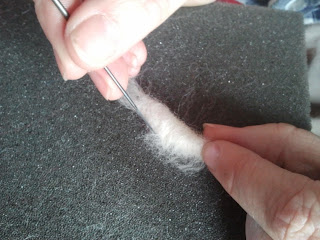I love the way time can transform pretty much anything into something beautiful.
This stunning piece can be found on the lovely quilting blog Cactus Needle. An ancestor of the blog's owner, Nedra, stitched this sampler in the 1850's.
First, you really don't need to spend a lot of money on fine linens for your pieces. I found a similar type material in the fabric section at Walmart that I have been using for years. Its nice and sturdy, equals about a 22 count linen, and is already a buff color. It's not polished and smooth like muslin, but instead has a great home-spun look and feel that I think lends itself wonderfully to the antique look.
Before you begin staining your fabric, you'll need to sew up the raw edges so you don't end up with a fraying mess during the whole process. I don't do anything special, just a simple straight stitch to hold the edges under. I like to machine wash and dry my fabric after I have sewn it. This takes out the stiffness and also pre-shrinks the fabric.
Wet your fabric, squeeze as much water out as you can get, then lay it onto an old jelly roll pan covered with foil. You can use your nice new jelly roll pan if you want to, it won't hurt it. The wrinkles in the fabric at this point help add interest to the stains.
Now, using a brush and some watered down walnut ink, brush the fabric to stain it. Be as perfect or uneven as you want. I myself prefer a very uneven look.
After you have covered the fabric with the walnut ink, add a second color to give your fabric an amazing pop. I use watered-down yellow ochre acylic paint. Just a tiny bit in about three different spots.
Finally, you'll want to add a final layer that really gives the look some dimension. Take some walnut ink, not the watered down stuff you used before, but straight, dark, gorgeous walnut ink. Drop it onto your fabric in about three different spots. Don't mess with it, just let it do it's thing. This is my favorite part.
Set the whole pan in the warm sun, on your counter, or in a warm oven to dry. I prefer the sun when drying anything stained with tea or walnut ink, but that's not always possible. I sometimes use a warm oven set to 170 degrees. Please keep an eye on it if you are doing the oven-drying method! I've never had a problem, but everyone's ovens are different. When your fabric is dry, iron it out and see how beautiful is has become!
My name is Marilyn Healey and I've been creating art my entire life. It was great fun sharing this technique with you!



















































